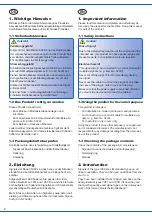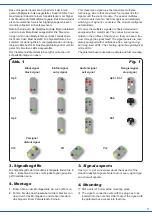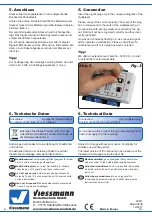
3
Das vorliegende Viessmann Signal ist mit der intelli-
genten Multiplextechnik ausgestattet. Dadurch führen nur
maximal vier Kabel mit einem Spezialstecker vom Signal
zum Steuermodul für Multiplex-Signale. Das Steuermodul
erkennt automatisch, welcher Signaltyp angeschlossen
ist und konfiguriert sich entsprechend.
Natürlich sind auch die Multiplex-Signale filigran detailliert
und mit einem Metallmast ausgestattet. Die Steuerlei-
tungen sind in den Mastprofilen versteckt, sodass freie
Sicht durch den Mast besteht! Die Signalschirme sind
komplett mit wartungsfreien, energiesparenden und lang-
lebigen LEDs bestückt. Das Rangierfahrtsignal ist vorbild-
gerecht mit weißen LEDs ausgestattet.
Der Viessmann-Patentsteckfuß sorgt für einfache und
schnelle Montage von oben.
This Viessmann signal use the innovative multiplex-
technology. Due to that, maximum four cables link the
signals and the control module. The special multiplex-
control module item-No. 5229 recognizes automatically
which type of signal is connected. The module configures
automatically.
Of cause the multiplex signals are finely detailed and
equipped with a metal mast. The connection wires are
hidden in the profiles of the mast, so that you have a free
view through the signal mast! The signal panels are com-
pletely equipped with maintenance-free, energy-saving
and long-lived LEDs. The shunting signal has prototypical
white LEDs.
The patented base socket allows simple and fast mounting.
3. Signalbegriffe
Die Signalbegriffe der Standard-Lichtsignale finden Sie in
Abb. 1. Beachten Sie, dass nicht jedes Signal jeden Be-
griff darstellen kann.
4. Montage
1.
Bohren Sie an der Montagestelle ein Loch (Ø 6 mm).
2.
Führen Sie das Anschlusskabel mit dem Stecker von
oben durch das Montageloch und stecken Sie dann
das Signal mit dem Patentsteckfuß hinein.
3. Signal aspects
See fig. 1 to get an overview about the aspects of the
standard daylight signals. Note that not every signal type
can show all aspects.
4. Mounting
1) Drill a hole (Ø 6 mm) at the mounting place.
2) The signal‘s connection wire with the plug has to be
inserted into the hole first. After that put the signal with
the patented base socket into that hole.
Fig. 1
Abb. 1
Hp0
Hp0 + Sh1
Hp1
Vr1
Hp2
Vr2
Blocksignal
block signal
Einfahrsignal
entry signal
Ausfahrsignal
exit signal
Rangiersignal
stop signal
Vr0
Sh0
Sh1
Vorsignal
distant signal






















